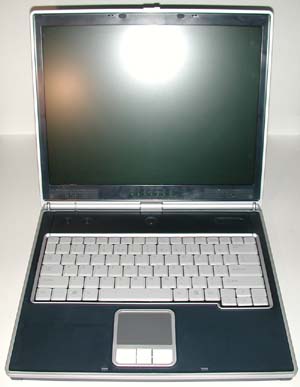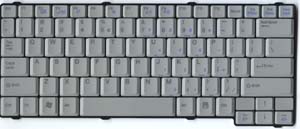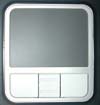Intel Centrino/Pentium-M Notebook Roundup: Dell, FIC and IBM Examined
by Matthew Witheiler on March 12, 2003 11:22 AM EST- Posted in
- Laptops
FIC Centrino - Build, Appearance, Size
Another notebook producer on the list of Pentium M launch partners is FIC who
will likely be ODMing (ordinal design manufacturering) for various companies.
We have not had a chance to look at any FIC notebooks to date (although we did
get our hands on their
From the outside the system looks and feels a lot like an Apple PowerBook. It is sleek and elegant with dark colors almost all the way around. The system is outfitted with a 14.1" TFT LCD panel that supports a max resolution of 1024x768 (XGA). We would have liked to see a higher resolution display in place, an SXGA or SXGA+ panel for example, but as this is an engineering unit it is very possible that the production FIC units will feature higher resolution displays.
The speakers on the FIC Centrino notebook are located on the monitor portion of the notebook below the LCD panel. This was surprising to see considering how thin the LCD panel is but is a wonderful place for speakers as sound is directed exactly where you are looking. In addition the speakers are not easily blocked by hands or wrists like some other speaker locations.
The keyboard on the FIC Centrino notebook is similar to the keyboards found on other Taiwanese notebooks we have seen, namely from ECS. The keyboard is full sized, offers dedicated arrow keys, and has fairly good key travel and tactile response (although we would call it a bit lower quality than the keyboard on the Dell and IBM systems). The control key on the keyboard is in the proper location (the far left key) and the keyboard features a Windows key as well.
We did have one problem with the keyboard on FIC's Centrino solution: only about half the keys worked. As an engineering unit this is not unheard of but it just goes to show you that the system is not yet ready to hit the store shelves. Thank goodness for USB keyboard support.
Mouse support is provided via a touch pad located below the keyboard. The touch pad was fairly standard in size and offers good sized buttons with excellent tactile response. Between the left and right mouse buttons is a scroll button rocker which can scroll up and down a current page.
There are a row of status LEDs located on the screen area below the LCD and between the speakers. The LEDs indicate power state, battery status, hard drive activity, wireless status, caps lock, scroll lock, and number lock.

There are also two status LEDs on the back of the LCD panel which are visible when the system is closed. These LEDs indicate power state and wireless connection status (if the wireless receiver is on or off).

Above the keyboard is the power button, the circular button in the center of the unit. There are also two access buttons to the left, one for launching the default internet browser and one for launching the default mail application.













3 Comments
View All Comments
builda - Thursday, February 2, 2006 - link
There appears to be a wide spread fault with the Gigabyte NB-1401 model notebook, where it reports having system disk errors or cannot find the hard disk. We have 7 of this model notebook and now 6 of them have reported the same problem. After running chkdsk to temporarily repair the errors that had been caused on the harddisk I found the problem returned the escalated to the point the harddisk could not be found. I further checked using Hitachi drive fitness testing tool which reported a cable error on each machine. Originally I returned 3 of these for repair as they were just outside the warranty period and the supplier checked with Gigabyte with the fix being to rub the cable all over with an eraser!! This worked for a short period but the problem has returned a couple of months later and has spread (like a virus) it now affects 6 out of the 7 notebooks. The supplier has just gone into administration and my next step is to approach Gigabyte who's support service has been found to be extremely unresponsive in the recent past.dbiberdorf - Tuesday, July 27, 2004 - link
I beg to differ with the reviewer. The keyboard on this unit is mediocre, and the track stick buttons are an abomination. They sit too low in the case and have too much travel. It makes my thumbs hurt after a while, and I often have to press them with a finger to get them to activate fully.The most powerful notebook in the world loses big points in my book if they built-in keyboard and pointing devices are weak. Certainly it's the case here. Dell, please figure out how to buy good keyboards for your machines!
Finally, the power adapter, while featuring convienent wrap-around cabling, is phenomenally large. My cordless phone at home is smaller. With the large profile of the machine, the adapter has to go in a side pocket of the carrying case, adding a little more bulge to your day.
visibilityunlimited - Thursday, October 30, 2003 - link
Screen resolution beyond SXGA+ would be unreadable using Windows for example while being more readable using Linux.Both the Linux text console and graphics mode X-windows-system screen drivers can be fully customized to display text at any resolution. The text characters could easily be displayed with current software at 1200dpi or more (if only the graphics processors and monitors could operate at that speed) and still retain the current character size. Text can currently be generated from vector based Type I and TrueType fonts for rasterizing at any resolution. Image scaling is a different and very easy problem.
The Windows OS is the real culprit holding back general usage of higher resolutions and typeset quality displays because of the OS being handicapped by the inertia of antique display modes. Darn. I want 3200x2400 or more!